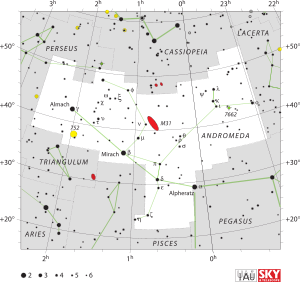Rho Andromedae
 | |
| Observation data Epoch J2000.0 Equinox J2000.0 | |
|---|---|
| Constellation | Andromeda |
| Right ascension | 00h 21m 07.26951s[1] |
| Declination | +37° 58′ 06.9804″[1] |
| Apparent magnitude (V) | +5.19[2] |
| Characteristics | |
| Spectral type | F5 III[3] |
| U−B color index | +0.039[2] |
| B−V color index | +0.424[2] |
| Astrometry | |
| Radial velocity (Rv) | +8.2[4] km/s |
| Proper motion (μ) | RA: +58.93[1] mas/yr Dec.: -38.56[1] mas/yr |
| Parallax (π) | 20.60 ± 0.21[1] mas |
| Distance | 158 ± 2 ly (48.5 ± 0.5 pc) |
| Absolute magnitude (MV) | +1.73[4] |
| Details | |
| Radius | 3.3[5] R☉ |
| Luminosity | 20[6] L☉ |
| Surface gravity (log g) | 3.84[7] cgs |
| Temperature | 6,471[7] K |
| Metallicity [Fe/H] | –0.09[7] dex |
| Rotational velocity (v sin i) | 44[7] km/s |
| Age | 1.3[4] Gyr |
| Other designations | |
| Database references | |
| SIMBAD | data |
Rho Andromedae (ρ And, ρ Andromedae) is the Bayer designation for a star in the northern constellation of Andromeda. It has an apparent visual magnitude of +5.19,[2] which, according to the Bortle Dark-Sky Scale, is bright enough to be seen with the naked eye from dark suburban skies. Based upon parallax measurements, this star is at a distance of approximately 158 light-years (48 parsecs) from Earth.[1]
The stellar classification of this star is F5 III,[3] indicating that it is in the giant stage of its stellar evolution. However, some sources list a classification of F5 IV,[3][6] suggesting that it may still be in the subgiant stage. The interferometry-measured angular diameter of this star is 0.626 mas,[6] which, at its estimated distance, equates to a physical radius of around 3.3 times the radius of the Sun.[5] The outer envelope is radiating around 20[6] times the luminosity of the Sun into space at an effective temperature of 6,471 K,[7] giving it the yellow-white hue of an F-type star.[8] It is about 1.3 billion years old.[4]
X-ray emissions were detected from this star during the EXOSAT mission.[9]
Naming
In Chinese, 天廄 (Tiān Jiù), meaning Celestial Stable, refers to an asterism consisting of ρ Andromedae, θ Andromedae and σ Andromedae. Consequently, ρ Andromedae itself is known as 天廄二 (Tiān Jiù èr, English: the Second Star of Celestial Stable.)[10]
References
- 1 2 3 4 5 6 van Leeuwen, F. (November 2007), "Validation of the new Hipparcos reduction", Astronomy and Astrophysics, 474 (2): 653–664, arXiv:0708.1752, Bibcode:2007A&A...474..653V, doi:10.1051/0004-6361:20078357.
- 1 2 3 4 Breger, M. (March 1968), "UBV and narrow-band UVBY photometry of bright stars", Astronomical Journal, 73: 84–85, Bibcode:1968AJ.....73...84B, doi:10.1086/110602.
- 1 2 3 4 "* rho And -- Star". SIMBAD. Centre de données astronomiques de Strasbourg. Retrieved 2012-06-24.
- 1 2 3 4 Nordström, B.; et al. (May 2004), "The Geneva-Copenhagen survey of the Solar neighbourhood. Ages, metallicities, and kinematic properties of ˜14 000 F and G dwarfs", Astronomy and Astrophysics, 418: 989–1019, arXiv:astro-ph/0405198, Bibcode:2004A&A...418..989N, doi:10.1051/0004-6361:20035959.
- 1 2 Lang, Kenneth R. (2006), Astrophysical formulae, Astronomy and astrophysics library, 1 (3rd ed.), Birkhäuser, ISBN 3-540-29692-1.
The radius (R*) is given by:
- 1 2 3 4 van Belle, G. T.; et al. (May 2008), "The Palomar Testbed Interferometer Calibrator Catalog", The Astrophysical Journal Supplement Series, 176 (1): 276–292, arXiv:0711.4194, Bibcode:2008ApJS..176..276V, doi:10.1086/526548.
- 1 2 3 4 5 Balachandran, Suchitra (May 1, 1990). "Lithium depletion and rotation in main-sequence stars". Astrophysical Journal, Part 1. 354: 310–332. Bibcode:1990ApJ...354..310B. doi:10.1086/168691.
- ↑ "The Colour of Stars", Australia Telescope, Outreach and Education, Commonwealth Scientific and Industrial Research Organisation, December 21, 2004, retrieved 2012-01-16.
- ↑ Gondoin, P.; Mangeney, A.; Praderie, F. (March 1987), "Solar-type giants - New X-ray detections from EXOSAT observations", Astronomy and Astrophysics, 174 (1–2): 187–196, Bibcode:1987A&A...174..187G.
- ↑ (in Chinese) AEEA (Activities of Exhibition and Education in Astronomy) 天文教育資訊網 2006 年 5 月 18 日